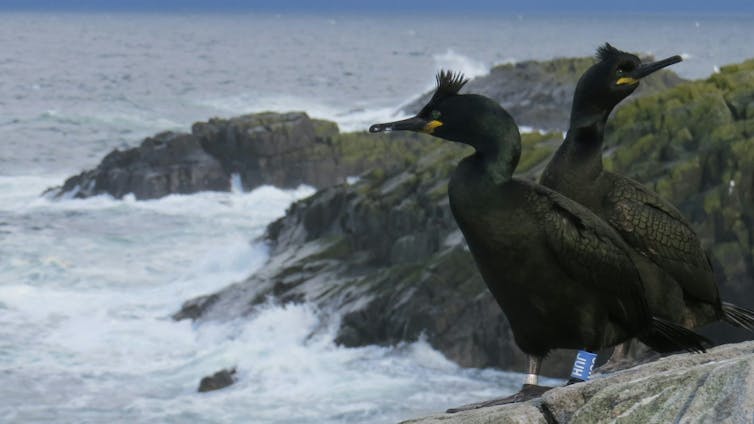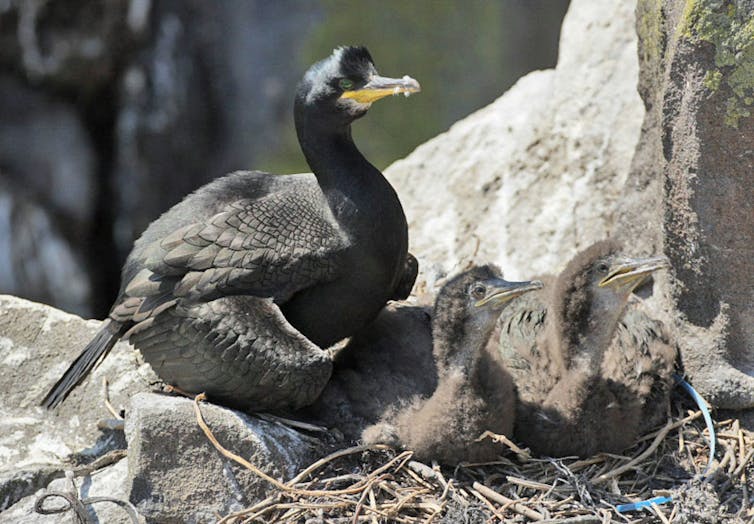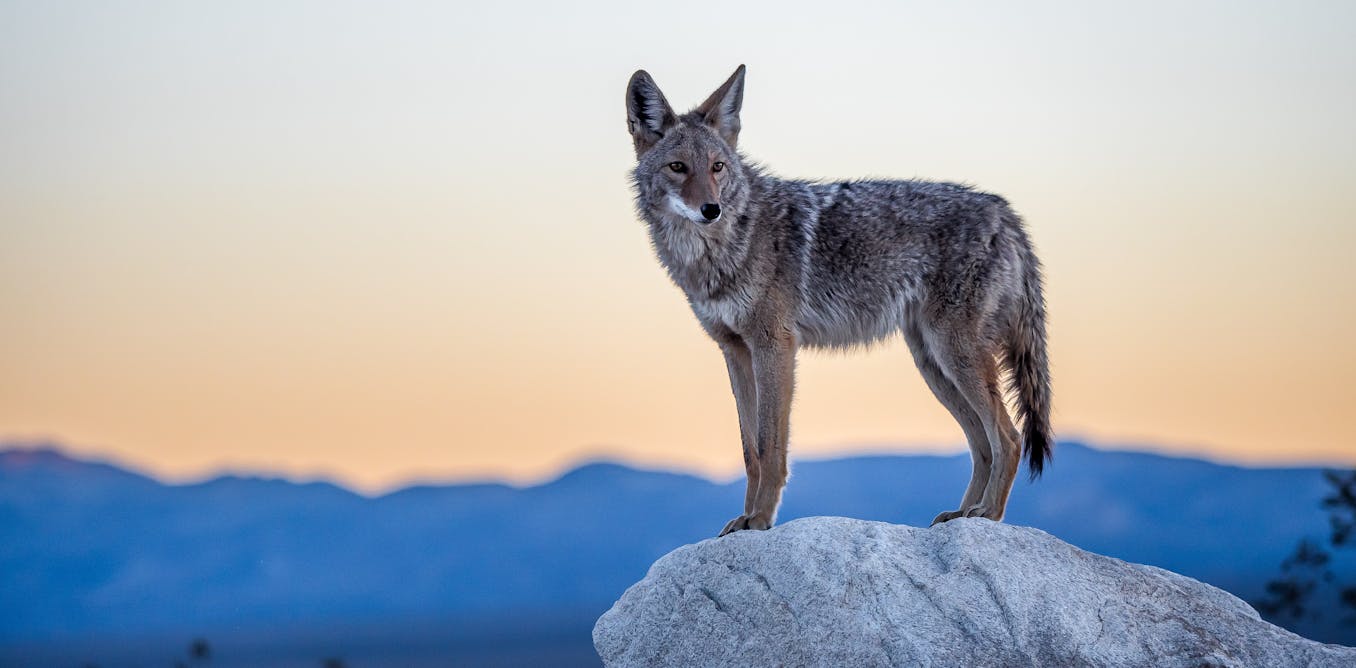The living world is profoundly affected by human activities. One eighth of species are currently threatened with extinction in the near future, largely due to climate change. Faced with the degradation of their habitat, the species that will survive will be those that are able to adapt. Our team of researchers is trying to gain a better understanding of how seasonal migration patterns are changing in the face of climate change by studying crested cormorants (Gulosus aristotelis). Long-term migration monitoring of this species, classified as endangered in the UK, began around fifteen years ago along the Scottish coast.
Jane Reid, Fourni par l’auteur
In response to rising temperatures (estimated at + 1.45C above pre-industrial levels in 2023), many plant and animal species in temperate zones are moving to higher altitudes or towards the poles, where temperatures are cooler. For many others, the annual events in their life cycle, such as migration, emergence from hibernation or reproduction, occur earlier in the year. Although such adaptations could theoretically be made possible by genetic evolution, they currently appear to be very rare in nature.
On top of a global rise in temperatures, climate change is leading to increasingly frequent and extreme weather events, such as storms, floods, fires. To survive these rapid and profound disruptions to their environment, some species may be able to escape these unpleasant episodes by migrating temporarily.
Migrating to adapt
Many animals migrate between two reproduction periods, undertaking what is known as seasonal migration. This type of migration is understood as a means of following the most favourable living conditions over the course of a year, but it can nevertheless represent a significant risk and energy cost. Depending on the environmental conditions, a compromise between migration and sedentary life has therefore sometimes evolved, and a surprising diversity of migratory behaviour exists within the animal kingdom.
Like most migratory species, the cormorant population we are studying is said to be partially migratory, since some individuals migrate along the coast during the winter, while others remain in the breeding area all year round. In summer and winter, the scientists walk along the shoreline to identify each individual cormorant, thanks to rings they have previously equipped them with that can be seen from a distance. Birds observed throughout the year in the breeding area are referred to as ‘residents’, while those found elsewhere in the autumn or winter are known as ‘migrants’. Thanks to more than 80,000 observations of 12,000 different cormorants, it is now possible to understand why certain birds choose to migrate, and how this could help them adapt to climate change.

Mark Newell, Fourni par l’auteur
We realised that during winter storms, a greater number of cormorants migrate, increasing their chances of survival compared with resident cormorants remaining in the breeding area. So how did the cormorants sense the arrival of a storm? Could this ability to redraw one’s migration route on the basis of environmental conditions be spreading to the rest of the population? In short, could the seasonal migration of cormorants help them face off the climate crisis?
How do cormorants choose to migrate?
To answer these questions, we are conducting a new study using advanced statistical models to predict the propensity of cormorants to migrate according to environmental conditions. One of the big challenges in such studies is that it’s impossible for scientists to track all the birds living freely in their natural environment. When you’re in the field, there are always some individuals that you won’t be able to detect.
Here, the trick is to distinguish statistically why certain cormorants were not observed during the coastal surveys. Were they in another wintering area? Out fishing or hiding behind a rock? Or did they not survive? By relating the chances of observing each ringed cormorant to its wintering area and to local environmental conditions throughout the year (such as temperature, rainfall, wind speed and direction, wave height, quantity of food, number of cormorants in the area, etc.), it is possible to find out to what extent, and depending on which components of their environment, cormorants choose to migrate or to stay.
Behavioural change passed down through the genes?
While the research is currently underway, we can already assert that in many cases behavioural changes won’t be enough to adapt to climate change. In some cases, it will only enable animals to respond in ways that are inadequate, too limited and/or too costly. Genetic adaptation will therefore often be necessary to allow natural populations to persist.

John Anderson, Author provided (no reuse)
Since the propensity to migrate makes it easier for cormorants to survive storms, this strategy could spread through the population via the process of natural selection. For this to happen, this migratory behaviour and its sensitivity to the environment must be at least partially genetic in origin. The genetic component explaining seasonal migration and its variability will be estimated from the family tree of cormorants in this region. By statistically cross-referencing the different migration strategies of the cormorants and their degree of relatedness (parent/child, grandparent/grandchild, cousin, etc.), it will be possible to deduce the heritable part of seasonal migration and its sensitivity to the environment, and therefore its potential for adaptation.
The aim of this project is to shed light on migratory species’ capacity for adaptation and resilience, which are still underresearched because they’re particularly complex to tackle. Our ability to predict the movements of migratory species and their potential evolution is essential for understanding the ecology of these species, which are particularly impacted by human activities, and thus pave the way for new conservation protocols. But let’s not forget that no leap in conservation science will be able to compensate for the growing environmental emergency caused by humans.
Led by Suzanne Bonamour, the PLASMIG research project is supervised by Professor Jane Reid and supported by researchers Paul Acker, Rita Fortuna and Cassandra Ugland from the Norwegian University of Science and Technology (NTNU), and Professor Francis Daunt from the UK Centre for Ecology and Hydrology (UKCEH).

The post “How cormorants are rethinking their migration routes in the face of climate change” by Suzanne Bonamour, Chercheuse post-doctorale (Marie Skłodowska-Curie), Norwegian University of Science and Technology was published on 08/21/2024 by theconversation.com







































Leave a Reply